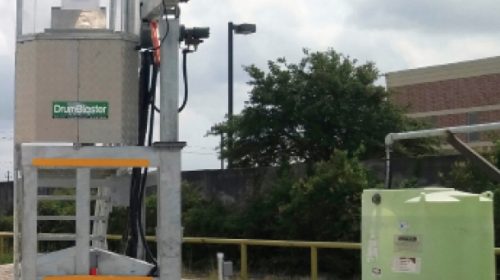A charter DrumBlaster Daily Washout System that Brisbane, Australia, developers unveiled two years ago for ready mixed concrete fleet demonstrations in Sydney and The Netherlands has been fine tuned and prepared for the global market.
|
|
| Campbell Concrete and other users note the DrumBlaster’s ease of startup and training measures, along with limited maintenance requirements. |
 |
 |
| Campbell Concrete is gauging DrumBlaster performance on three of 20 Harwin Plant mixers, comparing test and control vehicle tare weights as a reflection of barrels’ residual material build up volume. System installation requires only power and water source access. |
With drivers or designated operators safely perched in a shielded booth occupying a footprint under 5- x 7-ft., the DrumBlaster controls concrete buildup in mixer trucks typically with two cycles of three minutes each. A telescoping 8- or 10-m boom, tipped with multiple water jets set to approximately 300 psi, uses recycled water to blast residual concrete from the drum wall and fins. A key fob-activated system provides drivers or operators access to DrumBlaster controls and triggers electronics to record site details, truck number, date and wash times.
Data confirms system efficiency. Pilot installation figures from trucks maintained with DrumBlaster were compared against control mixers maintained by conventional washout methods. After measurement periods of up to 18 weeks, users concluded from truck tare weights that the DrumBlaster group averaged drum and fin build up volume nearly 85 percent below that of the control vehicles.
Pilot producers included Sydney’s Hanson Concrete and Houston’s Campbell Concrete & Materials LLC, both subsidiaries of HeidelbergCement Group, Germany. The premier North American DrumBlaster user, Campbell Concrete has tested the DrumBlaster on three trucks at its Harwin Plant, a workhorse supplying high performance concrete orders to downtown Houston high-rise building projects. The producer pinpointed the site as a good equipment trial candidate due to its high output of cementitious materials-rich mixes, which tend to hasten residual material build up on drum walls and fins versus conventional concrete loads.
After a month and a half of truck cleaning, maintenance and tare weight data collection, Campbell Concrete sees material build up reduction consistent with Hanson Sydney and other overseas peers. Additional numbers spell a water savings of 30 percent when the producer compares DrumBlaster cycle consumption against volumes typical of drivers washing out by hose. The new equipment likewise cuts by more than half the time they require to clean their drums for a day’s final wash out.
“We want three months of observation before doing a cost benefit analysis,” says Campbell Concrete Director of Operations Don Last. “Early numbers suggest we could see a quick payback on the equipment investment.”
Drivers have been very positive on the system, he adds: “All they need to do is position the truck at the station, walk up a few stairs, swipe a fob and push a few buttons. They are completely protected from washout splash back and do not need to climb the truck at any point.”
DrumBlaster is represented domestically by Tampa-based Product Manager, North America Jim Shedden, 727/331-3796, [email protected]
